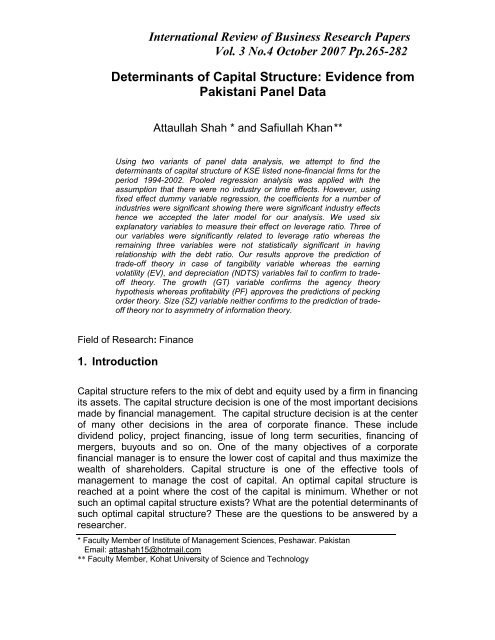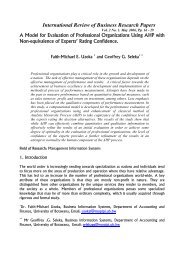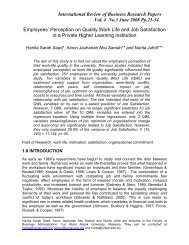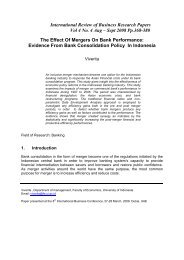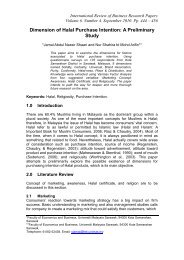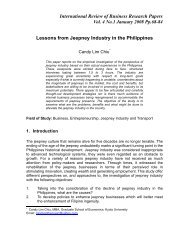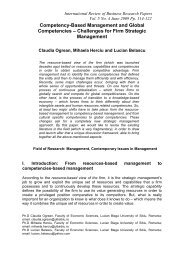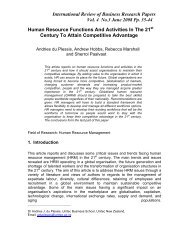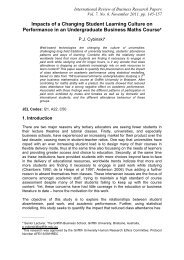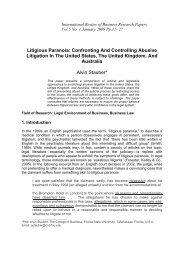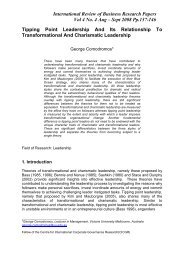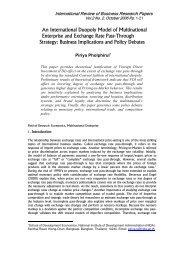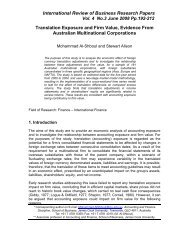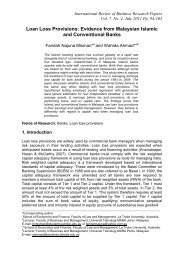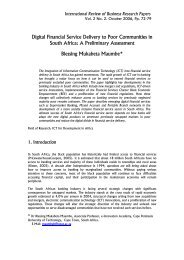Determinants of Capital Structure: Evidence from Pakistani Panel Data
Determinants of Capital Structure: Evidence from Pakistani Panel Data
Determinants of Capital Structure: Evidence from Pakistani Panel Data
Create successful ePaper yourself
Turn your PDF publications into a flip-book with our unique Google optimized e-Paper software.
International Review <strong>of</strong> Business Research Papers<br />
Vol. 3 No.4 October 2007 Pp.265-282<br />
<strong>Determinants</strong> <strong>of</strong> <strong>Capital</strong> <strong>Structure</strong>: <strong>Evidence</strong> <strong>from</strong><br />
<strong>Pakistani</strong> <strong>Panel</strong> <strong>Data</strong><br />
Attaullah Shah * and Safiullah Khan**<br />
Using two variants <strong>of</strong> panel data analysis, we attempt to find the<br />
determinants <strong>of</strong> capital structure <strong>of</strong> KSE listed none-financial firms for the<br />
period 1994-2002. Pooled regression analysis was applied with the<br />
assumption that there were no industry or time effects. However, using<br />
fixed effect dummy variable regression, the coefficients for a number <strong>of</strong><br />
industries were significant showing there were significant industry effects<br />
hence we accepted the later model for our analysis. We used six<br />
explanatory variables to measure their effect on leverage ratio. Three <strong>of</strong><br />
our variables were significantly related to leverage ratio whereas the<br />
remaining three variables were not statistically significant in having<br />
relationship with the debt ratio. Our results approve the prediction <strong>of</strong><br />
trade-<strong>of</strong>f theory in case <strong>of</strong> tangibility variable whereas the earning<br />
volatility (EV), and depreciation (NDTS) variables fail to confirm to trade<strong>of</strong>f<br />
theory. The growth (GT) variable confirms the agency theory<br />
hypothesis whereas pr<strong>of</strong>itability (PF) approves the predictions <strong>of</strong> pecking<br />
order theory. Size (SZ) variable neither confirms to the prediction <strong>of</strong> trade<strong>of</strong>f<br />
theory nor to asymmetry <strong>of</strong> information theory.<br />
Field <strong>of</strong> Research: Finance<br />
1. Introduction<br />
<strong>Capital</strong> structure refers to the mix <strong>of</strong> debt and equity used by a firm in financing<br />
its assets. The capital structure decision is one <strong>of</strong> the most important decisions<br />
made by financial management. The capital structure decision is at the center<br />
<strong>of</strong> many other decisions in the area <strong>of</strong> corporate finance. These include<br />
dividend policy, project financing, issue <strong>of</strong> long term securities, financing <strong>of</strong><br />
mergers, buyouts and so on. One <strong>of</strong> the many objectives <strong>of</strong> a corporate<br />
financial manager is to ensure the lower cost <strong>of</strong> capital and thus maximize the<br />
wealth <strong>of</strong> shareholders. <strong>Capital</strong> structure is one <strong>of</strong> the effective tools <strong>of</strong><br />
management to manage the cost <strong>of</strong> capital. An optimal capital structure is<br />
reached at a point where the cost <strong>of</strong> the capital is minimum. Whether or not<br />
such an optimal capital structure exists? What are the potential determinants <strong>of</strong><br />
such optimal capital structure? These are the questions to be answered by a<br />
researcher.<br />
* Faculty Member <strong>of</strong> Institute <strong>of</strong> Management Sciences, Peshawar. Pakistan<br />
Email: attashah15@hotmail.com<br />
** Faculty Member, Kohat University <strong>of</strong> Science and Technology
Shah & Khan 266<br />
In other words, the job <strong>of</strong> a researcher is to identify the potential determinants <strong>of</strong><br />
capital structure in a given institutional settings, industries and/or capital<br />
markets. The corporate financial managers thus can benefit <strong>from</strong> this to make an<br />
optimal mix <strong>of</strong> debt and equity in order to minimize the cost <strong>of</strong> capital.<br />
Quite a large strand <strong>of</strong> theoretical and empirical research has focused on the<br />
area <strong>of</strong> capital structure since the path-breaking paper on capital structure by<br />
Miller and Modigliani published in 1958. However, most <strong>of</strong> the research work has<br />
been carried out in developed economies and very little is known about the<br />
capital structure <strong>of</strong> firms in developing economies. With this very little research,<br />
we are not sure whether conclusions <strong>from</strong> theoretical and empirical research<br />
carried out in developed economies are valid for developing countries too; or a<br />
different set <strong>of</strong> factors influence capital structure decisions in developing<br />
countries? We are not sure whether conclusions <strong>from</strong> research on capital<br />
structure are portable across countries in general. Rajan and Zingales (1995)<br />
studied the G-7 countries while Booth et al (2001) extended this work by<br />
including some data <strong>from</strong> emerging markets. The conclusions <strong>from</strong> these studies<br />
were that there were some common features in the capital structures <strong>of</strong> firms in<br />
different countries but that further research was necessary to identify the<br />
determinants <strong>of</strong> capital structure in particular institutional settings or countries.<br />
Pakistan is a developing country with three stock exchanges, the Karachi Stock<br />
Exchange (KSE) being the largest one. More than 700 companies are listed on<br />
KSE. Like other developing economies, the area <strong>of</strong> capital structure is relatively<br />
unexplored in Pakistan. Limited research work exists on this area, like Booth et al<br />
(2001) studied 10 developing countries including Pakistan. However, this study<br />
was confined only to top 100 index companies. Second study by Shah and Hijazi<br />
(2004) was an improvement on the first one as it included all non-financial firms<br />
listed on KSE for the period 1997-2001. However, the second study too was<br />
basic in nature in terms <strong>of</strong> its use <strong>of</strong> pooled regression model avoiding the fixed<br />
effects and random effects models. The purpose <strong>of</strong> this study is to extend the<br />
work <strong>of</strong> Shah and Hijazi (2004) by including more years, using relevant models <strong>of</strong><br />
panel data and including more explanatory variables.<br />
The paper is organized as follows: first section <strong>of</strong> the paper gives a brief<br />
introduction <strong>of</strong> the background <strong>of</strong> the study. Section 2 summarizes the related<br />
literature. Section 3 gives description <strong>of</strong> the data and measurement <strong>of</strong> the<br />
variables. Section 4 presents the discussion on specification <strong>of</strong> model. Section 5<br />
discusses the results <strong>from</strong> the models used and section 6 presents the<br />
conclusion.
Shah & Khan 267<br />
2. Related Literature<br />
The first paper on capital structure was written by Miller and Modigliani in 1958.<br />
They conceptually proved that the value <strong>of</strong> firm in not dependent upon the capital<br />
structure decision given that certain conditions are met. Because <strong>of</strong> the<br />
unrealistic assumptions in MM irrelevance theory, research on capital structure<br />
gave birth to other theories. The trade <strong>of</strong>f theory says that a firm’s adjustment<br />
toward an optimal leverage is influenced by three factors namely taxes, costs <strong>of</strong><br />
financial distress and agency costs. Baxter (1967) argued that the extensive use<br />
<strong>of</strong> debt increases the chances <strong>of</strong> bankruptcy because <strong>of</strong> which creditors demand<br />
extra risk premium. He said that firms should not use debt beyond the point<br />
where the cost <strong>of</strong> debt becomes larger than the tax advantage. Kraus and<br />
Litzenberger (1973) argue that if a firm’s debt obligations are greater than its<br />
earnings then the firm’s market value is necessarily a concave function <strong>of</strong> its debt<br />
obligations. DeAngelo and Masulis (1980) worked further on Miller’s differential<br />
tax model by including other non-debt shields such as depreciation charges and<br />
investment tax credits. They concluded that each firm has an internal optimal<br />
capital structure that maximizes its value. The capital structure is determined only<br />
by the interactions <strong>of</strong> personal and corporate taxes as well as positive defaults<br />
costs. Altman (1984) was the first to identify direct and indirect costs <strong>of</strong><br />
bankruptcy. By studying 12 retail and 7 industrial firms, he found that firms in the<br />
sample faced 12.2% <strong>of</strong> indirect bankruptcy costs at time t-1 and 16.7% at time t.<br />
He concluded that capital structure should be such that the present value <strong>of</strong><br />
marginal tax benefits is equal to marginal present value <strong>of</strong> bankruptcy costs.<br />
Bradley, Jarrell and Kim (1984) used a model that synthesized modern balancing<br />
theory <strong>of</strong> optimal capital structure. They found strong direct relationship between<br />
non-tax shields and the firm’s debt level.<br />
Agency theory suggests that there exists an optimal debt level in capital structure<br />
that can minimize the above agency costs. To mitigate the agency problems,<br />
various methods have been suggested. Jensen and Meckling (1976) suggest<br />
either to increase the ownership <strong>of</strong> the managers in the firm in order to align the<br />
interest <strong>of</strong> mangers with that <strong>of</strong> the owners or increase the use <strong>of</strong> debt which will<br />
reduce the equity base and thus increase the percentage <strong>of</strong> equity owned by<br />
mangers. (Grossman and Hart, 1982) suggest that the use <strong>of</strong> debt increases the<br />
chances <strong>of</strong> bankruptcy and job loss that further motivate managers to use the<br />
organizational resources efficiently and reduce their consumption on perks.<br />
Jensen (1986) present free-cash flow hypothesis. Free cash flow refers to cash<br />
flow available after funding all projects with positive cash flows. Managers having<br />
less than 100% stake in business and their compensation tied to firm’s expansion<br />
may try to use the free cash flows sub-optimally and increase firm size resulting<br />
in greater compensation (Baker, Jensen , and Murphy, (1988); Donaldson, 1984)<br />
. Jensen (1986) suggests that this problem can be somehow controlled by<br />
increasing the stake <strong>of</strong> managers in the business or by increasing debt in the
Shah & Khan 268<br />
capital structure, thereby reducing the amount <strong>of</strong> “free” cash available to<br />
managers.<br />
Harris and Reviv (1990) gave one more reason <strong>of</strong> using debt in capital structure.<br />
They say that management will hide information <strong>from</strong> shareholders about the<br />
liquidation <strong>of</strong> the firm even if the liquidation will be in the best interest <strong>of</strong><br />
shareholders because managers want the perpetuation <strong>of</strong> their service. Similarly,<br />
Amihud and Lev (1981) suggest that mangers have incentives to pursue<br />
strategies that reduce their employment risk. This conflict can be solved by<br />
increasing the use <strong>of</strong> debt financing since bondholders will take control <strong>of</strong> the firm<br />
in case <strong>of</strong> default as they are powered to do so by the debt indentures. Stulz<br />
(1990) said when shareholders cannot observe either the investing decisions <strong>of</strong><br />
management or the cash flow position in the firm, they will use debt financing.<br />
Managers, to maintain credibility, will over-invest if it has extra cash and underinvest<br />
if it has limited cash. Stulz (1990) argued that to reduce the cost <strong>of</strong><br />
underinvestment and overinvestment, the amount <strong>of</strong> free cash flow should be<br />
reduced to management by increasing debt financing.<br />
Another approach to explain the capital structure <strong>of</strong> firms is the differences in the<br />
level <strong>of</strong> information, which the insiders and outsiders have about the investment<br />
opportunities and income distribution <strong>of</strong> the firm. Myers (1984) provided<br />
theoretical basis for this theory. He said that there exists a degree <strong>of</strong> asymmetry<br />
<strong>of</strong> information between the firm’s managers and investors concerning the real<br />
value <strong>of</strong> firm’s present and future investment. Ross (1977) says that mangers<br />
have better knowledge <strong>of</strong> the income distribution <strong>of</strong> a firm. When they issue debt,<br />
it may generate positive signals to the outside world about the firm’s income<br />
distribution suggesting that the firm has stable income and is able to pay the<br />
periodic installments and interest payments. In this regard, higher debt may show<br />
higher confidence <strong>of</strong> managers in the firm’s smooth income distribution and<br />
adequacy <strong>of</strong> the income. Thus firms in their efforts to increase investors’<br />
confidence and thus increase the value <strong>of</strong> equity will use higher debt in the<br />
capital structure.<br />
3. <strong>Data</strong> And Measurement Of Variables<br />
The study is based on the data taken <strong>from</strong> the State Bank <strong>of</strong> Pakistan<br />
publications “Balance Sheet Analysis <strong>of</strong> Joint Stock Companies Listed on The<br />
Karachi Stock Exchange Volume-II 1993-1999” and Volume-II 1997-2002. This<br />
publication provides useful information on key accounts <strong>of</strong> the financial<br />
statements <strong>of</strong> all listed firms <strong>of</strong> KSE. We excluded all firms in financial sector<br />
<strong>from</strong> our analysis as the capital structures <strong>of</strong> these firms are not comparable to<br />
the capital structures <strong>of</strong> firms in non-financial sector. Specifically, we excluded<br />
banks, insurance companies, and investment companies. We also excluded<br />
those firms <strong>from</strong> our analysis for which complete data was not available for the<br />
stated period. To avoid outlier in the data that could possibly distort the analysis,
Shah & Khan 269<br />
we excluded all observations that had values at least three standard deviation<br />
<strong>from</strong> the average value <strong>of</strong> all firms. Finally we were left with the sample <strong>of</strong> 286<br />
firms in non-financial sector industries listed on Karachi Stock Exchange <strong>from</strong><br />
1993 to 2002. As we shall discuss next, two <strong>of</strong> our variables required the<br />
computation <strong>of</strong> yearly change and because <strong>of</strong> that one year had to be dropped.<br />
Thus we were left with 9 years excluding year 1993.<br />
3.1 Dependent And Independent Variables<br />
After discussing the various theories <strong>of</strong> capital structure, now we discuss the<br />
dependent variable and its potential determinants. We take the debt to total<br />
assets ratio as a proxy for leverage (dependent variable). For potential<br />
determinants <strong>of</strong> leverage, we study six independent variables namely tangibility,<br />
size, growth, pr<strong>of</strong>itability, earning volatility, and non-debt tax shields.<br />
3.1.1 Measure <strong>of</strong> Leverage (LG)<br />
Previous studies suggest that the level <strong>of</strong> leverage depends upon the definition <strong>of</strong><br />
leverage. Several research studies have used both market and book value based<br />
measures <strong>of</strong> leverage (Titman and Wessels 1988, Rajan and Zingales 1995).<br />
The former measure divides book value <strong>of</strong> debt by book value <strong>of</strong> debt plus<br />
market value <strong>of</strong> equity and the later measure divides the book value <strong>of</strong> debt by<br />
book value <strong>of</strong> debt plus book value <strong>of</strong> equity. We use the book value measure <strong>of</strong><br />
leverage. This can be justified with the argument that optimal level <strong>of</strong> leverage is<br />
determined by the trade-<strong>of</strong>f between the benefits and costs <strong>of</strong> debt financing. The<br />
main benefit <strong>of</strong> leverage is the cash savings generated because <strong>of</strong> the debt-tax<br />
shield. This tax shield benefits are not changed by market value <strong>of</strong> the debt once<br />
it is issued (Banerjee, S. et al 2000). This is why market value <strong>of</strong> debt becomes<br />
irrelevant. On the other hand, the primary cost <strong>of</strong> borrowing is the increased<br />
chances <strong>of</strong> bankruptcy. If a firm falls in financial distress and goes into<br />
bankruptcy, then the relevant value <strong>of</strong> the debt is the book value <strong>of</strong> debt. Finally,<br />
book value measure provides relative ease and accuracy with which it can be<br />
calculated.<br />
Another consideration in deciding the appropriate measure <strong>of</strong> leverage is to take<br />
total debt or only long term debt as a percentage <strong>of</strong> total assets. Though capital<br />
structure theories consider long term debt as a proxy for financial leverage, we<br />
use the measure <strong>of</strong> total debt because in Pakistan firms have mostly short-term<br />
financing as the average firm size is small which makes access to capital market<br />
difficult in terms <strong>of</strong> cost and technical difficulties (Shah and Hijazi 2004). The<br />
main sources <strong>of</strong> debt in Pakistan have been commercial banks, which do not<br />
encourage long term loans, with almost no reliance on market based debt until<br />
mid 1994 when government moved to remove most <strong>of</strong> the constraints among
Shah & Khan 270<br />
which one action was to amend company law to permit corporate entities to raise<br />
debt directly <strong>from</strong> the market in the form <strong>of</strong> TFCs (Term Finance Certificates). So<br />
corporate bond market has limited history and is in the process <strong>of</strong> development.<br />
This explains why firms on average in Pakistan have more short term financing<br />
than long term financing. Booth et al (1999) also pointed in their study on<br />
determinants <strong>of</strong> capital structure in developing countries including Pakistan that<br />
the use <strong>of</strong> short term financing is higher than long term financing in developing<br />
countries.<br />
3.1.2 Independent Variables<br />
3.1.2.1 Tangibility <strong>of</strong> Assets (TG)<br />
A firm with large amount <strong>of</strong> fixed asset can borrow at relatively lower rate <strong>of</strong><br />
interest by providing the security <strong>of</strong> these assets to creditors. Having the<br />
incentive <strong>of</strong> getting debt at lower interest rate, a firm with higher percentage <strong>of</strong><br />
fixed asset is expected to borrow more as compared to a firm whose cost <strong>of</strong><br />
borrowing is higher because <strong>of</strong> having less fixed assets. Thus we expect a<br />
positive relationship between tangibility <strong>of</strong> assets and leverage. We measure<br />
tangibility <strong>of</strong> asset (TG) as a ratio <strong>of</strong> fixed assets divided by total assets. We take<br />
total net amount <strong>of</strong> fixed assets as the numerator. Using total net amount <strong>of</strong> fixed<br />
assets means the cost <strong>of</strong> fixed assets minus accumulated depreciation. Our first<br />
hypothesis is:<br />
Hypothesis 1: A firm with higher percentage <strong>of</strong> fixed assets will have higher debt<br />
ratio<br />
3.1.2.2 Size (SZ)<br />
There are two conflicting viewpoints about the relationship <strong>of</strong> size to leverage <strong>of</strong><br />
a firm. First, large firms don’t consider the direct bankruptcy costs as an active<br />
variable in deciding the level <strong>of</strong> leverage as these costs are fixed by constitution<br />
and constitute a smaller proportion <strong>of</strong> the total firm’s value. And also, larger firms<br />
being more diversified have lesser chances <strong>of</strong> bankruptcy (Titman and Wessels<br />
1988). Following this, one may expect a positive relationship between size and<br />
leverage <strong>of</strong> a firm. Second, contrary to first view, Rajan and Zingales (1995)<br />
argue that there is less asymmetrical information about the larger firms. This<br />
reduces the chances <strong>of</strong> undervaluation <strong>of</strong> the new equity issue and thus<br />
encourages the large firms to use equity financing. This means that there is<br />
negative relationship between size and leverage <strong>of</strong> a firm. Following Rajan and<br />
Zingales (1995), we expect a negative relationship between size and leverage <strong>of</strong><br />
the firm. We measure size (SZ) <strong>of</strong> the firm by the taking the natural log <strong>of</strong> the<br />
sales as this measure smoothens the variation in the figure over the periods <strong>of</strong><br />
time.<br />
Hypothesis 2: There is negative relationship between size and leverage <strong>of</strong> the<br />
firm.
Shah & Khan 271<br />
3.1.2.3 Growths (GT)<br />
Empirically, there is much controversy about the relationship between growth<br />
rate and level <strong>of</strong> leverage. According to pecking order theory hypothesis, a firm<br />
will use first internally generated funds which may not be sufficient for a growing<br />
firm. And next options for the growing firms is to use debt financing which<br />
implies that a growing firm will have a high leverage (Drobetz and Fix 2003). On<br />
the other hand, agency costs for growing firms are expected to be higher as<br />
these firms have more flexibility with regard to future investments. The reason is<br />
that bondholders fear that such firms may go for risky projects in future as they<br />
have more choice <strong>of</strong> selection between risky and safe investment opportunities.<br />
Deeming their investments at risk in future, bondholders will impose higher costs<br />
at lending to growing firms. Growing firms, thus, facing higher cost <strong>of</strong> debt will<br />
use less debt and more equity. Congruent with this, Titman and Wessels (1988),<br />
Barclay et al. (1995) and Rajan and Zingales (1995) all find a negative<br />
relationship between growth opportunities and leverage. Initially we expect that<br />
firms with higher growth opportunities will have lower level <strong>of</strong> leverage. Different<br />
research studies have used different measures <strong>of</strong> growth; like market to book<br />
value <strong>of</strong> equity, research expenditure to total sales measure and annual<br />
percentage increase in total assets (Titman and Wessels, 1988).Given the<br />
structure <strong>of</strong> data we measure growth (GT) as a percentage increase in total<br />
assets, as the data was taken <strong>from</strong> the State Bank <strong>of</strong> Pakistan publication which<br />
does not contain information on annual stock prices and research expenditure <strong>of</strong><br />
the listed firms.<br />
Hypothesis 3: Firms with higher growth rate will have lower leverage.<br />
3.1.2.4 Pr<strong>of</strong>itability (PF)<br />
Given the pecking order hypothesis firms tend to use internally generated funds<br />
first and than resort to external financing. This implies that pr<strong>of</strong>itable firms will<br />
have less amount <strong>of</strong> leverage (Myers and Majluf 1984). We expect a negative<br />
relationship between pr<strong>of</strong>itability and leverage. We measure pr<strong>of</strong>itability (PF) as<br />
the ratio <strong>of</strong> net income after taxes divided by total sales.<br />
Hypothesis 4: Firms with higher pr<strong>of</strong>itability will have lesser leverage.<br />
3.1.2.5 Earning volatility (EV)<br />
Earning volatility is considered to be either the inherent business risk in the<br />
operations <strong>of</strong> a firm or a result <strong>of</strong> inefficient management practices. In either case<br />
earning volatility is proxy for the probability <strong>of</strong> financial distress and the firm will<br />
have to pay risk premium to outside fund providers. To reduce the cost <strong>of</strong> capital,<br />
a firm will first use internally generated funds and then outsider funds. This<br />
suggests that earning volatility is negatively related with leverage. This is the<br />
combined prediction <strong>of</strong> trade-<strong>of</strong>f theory and pecking order theory. However,<br />
Cools (1993) says that agency theory suggests positive relationship between<br />
earning volatility and leverage. He says that the problem <strong>of</strong> underinvestment
Shah & Khan 272<br />
decreases when the volatility <strong>of</strong> firms returns increases. Following the prediction<br />
<strong>of</strong> trade-<strong>of</strong>f theory and pecking order theory, we expect negative relationship<br />
between earning volatility (EV) and leverage. We use the value <strong>of</strong> the deviations<br />
<strong>from</strong> mean <strong>of</strong> net pr<strong>of</strong>it divided by total number <strong>of</strong> years for each firm in the given<br />
year as proxy <strong>of</strong> earning volatility.<br />
Hypotheses 5: Earning volatility (EV) is negatively related to leverage<br />
3.1.2.6 Non-Debt Tax Shields<br />
Non-debt tax shields (NDTS) include depreciation and investment tax credits.<br />
DeAngelo and Masulis (1980) say that non-debt tax shields can be substitutes for<br />
the tax benefits <strong>of</strong> debt financing and a firm with larger non-debt tax shields is<br />
expected to use less debt. We expect negative relationship between NDTS and<br />
leverage. The empirical evidence on use <strong>of</strong> proxy for NDTS is almost the same.<br />
For example, Bradley et al. (1984) used the sum <strong>of</strong> annual depreciation charges<br />
and investment tax credits divided by earnings before depreciation, interest, and<br />
taxes to measure NDTS. They find leverage is positively related with NDTS.<br />
Wald (1999) uses the ratio <strong>of</strong> depreciation to total assets and Chaplinsky and<br />
Niehaus (1993) employ the ratio <strong>of</strong> depreciation expense plus investment tax<br />
credits to total assets to measure NDTS. Both studies find that leverage is<br />
negatively correlated with NDTS. In this study, we use annual depreciation<br />
charges divided by total assets to calculate non-debt tax shields.<br />
Hypothesis 6: NDTS are negatively related to leverage.<br />
The following table presents descriptive statistics for the variables discussed<br />
above.<br />
Table 1 Means <strong>of</strong> selected variables by industries<br />
Textile Chemicals Engineering Sugar Paper Power Cement Misc:<br />
Leverage(LG) 0.723 0.505 0.698 0.601 0.618 0.662 0.596 0.663<br />
Depreciation(NDTS) 0.052 0.038 0.034 0.100 0.035 0.039 0.053 0.036<br />
Pr<strong>of</strong>itability(PF) -0.014 0.049 -0.029 -0.012 0.040 0.055 -0.015 0.000<br />
Tangibility(TG) 0.552 0.393 0.351 0.613 0.463 0.386 0.655 0.384<br />
Size(SZ) 6.290 6.239 6.091 6.593 5.329 8.696 7.189 5.860<br />
Growth(GT) 0.074 0.084 0.072 0.066 0.062 0.129 0.067 0.086<br />
Volatility(EV) 4.628 7.506 6.552 4.235 3.849 28.300 12.000 5.113<br />
Analysis <strong>of</strong> the above table shows that leverage ratio is the highest in textile<br />
industry followed by engineering industry. Textile industry has an average <strong>of</strong><br />
0.723 leverage against the mean leverage <strong>of</strong> 0.666 <strong>of</strong> all industries. Two possible<br />
explanations can be given. First, textile industry is relatively more capital<br />
intensive. Hence, the hypothesis that asset tangibility is positively related to<br />
leverage may be true in this case. However, the tangibility ratio <strong>of</strong> .665 is highest<br />
for cement followed by average tangibility ratio <strong>of</strong> 0.613 for sugar industry. Textile
Shah & Khan 273<br />
industry comes at third position with regard to tangibility ratio <strong>of</strong> 0 .552. Hence,<br />
the first explanation is not powerful.<br />
The second explanation may be given <strong>from</strong> the point <strong>of</strong> view <strong>of</strong> family control on<br />
textile industry. Like Ghani and Ashraf (2005) found that most <strong>of</strong> the textile firms<br />
are in the ownership <strong>of</strong> groups and family members. They found that 60% <strong>of</strong> the<br />
total group firms belong to the Textile and related sectors as against 47% for the<br />
non-group firms. They say this is consistent with the fact that Bhutto’s regime, in<br />
1972, did not nationalize textile holdings <strong>of</strong> the 22 families, which in turn,<br />
subsequently helped families consolidate and expand, in these sectors. Based<br />
on the anecdotal evidence, family controlled firms try to take pr<strong>of</strong>its out business<br />
in forms other than dividend so as to avoid income and dividend taxes. This is<br />
done either through inflating the cost <strong>of</strong> production or by deflating sales figures.<br />
The result is negative net income figure in the income statement year after year<br />
and negative equity figure in the balance sheet. Because <strong>of</strong> this phenomenon,<br />
leverage ratio is above one for many textile firms. And hence the average<br />
leverage ratio for textile industry is higher than average leverage ratio <strong>of</strong> any<br />
other industry. Even though we excluded many observations <strong>from</strong> our analysis<br />
that were 3 standard deviation <strong>from</strong> the average <strong>of</strong> all observations, still there<br />
were many such firms whose debt ratio was more than 0.90 or above one in the<br />
textile industry.<br />
Again consistent with the above discussion, average pr<strong>of</strong>itability ratio is negative<br />
in textile industry. It is also negative in engineering, cement and sugar industries.<br />
Most <strong>of</strong> these industries are owned by groups and families. Pr<strong>of</strong>itability is positive<br />
in chemical, power, paper and miscellaneous industries. Many firms in these<br />
industries are in foreign ownership and hence report true pr<strong>of</strong>its. Power industry<br />
has the largest firms followed by cement industry. Log <strong>of</strong> sales (proxy for size)<br />
value is 8.696 for power industry and 7.189 for cement industry. Power industry<br />
has several very large firms like Pakistan Refinery, Shell Pakistan, National<br />
Refinery, Pakistan State Oil, Sui Northern Gas Pipeline; The Karachi Electric<br />
Supply Company etc. All <strong>of</strong> these firms have sales figures in billions. Power<br />
industry has also the highest growth rate. In summary, power industry has higher<br />
sales, positive pr<strong>of</strong>itability and highest growth rate. The pecking order theory<br />
holds true here that growing firms first finance their projects <strong>from</strong> internally<br />
generated funds. Too, in the following table <strong>of</strong> correlation among independent<br />
variables, we find that pr<strong>of</strong>itability is positively correlated with growth.<br />
4. Model Specification<br />
<strong>Panel</strong> data follows a given sample <strong>of</strong> individuals over time, and thus provides<br />
multiple observations on each individual in the sample. <strong>Panel</strong> data combines the<br />
features <strong>of</strong> time series and cross-section. It provides information on a number <strong>of</strong><br />
statistical units for a number <strong>of</strong> years. <strong>Panel</strong> data for economic research has<br />
several advantages over cross-sectional or time- series sets. <strong>Panel</strong> data usually<br />
provides the researcher a large number <strong>of</strong> data points, increasing the degrees <strong>of</strong>
Shah & Khan 274<br />
freedom and reducing the collinaerity among explanatory variables; hence<br />
improving the efficiency <strong>of</strong> econometric estimates.<br />
4.1 Constant Coefficient Model<br />
This is also known as pooled regression. This is the simplest <strong>of</strong> all the panel data<br />
models. The model disregards the time, space or individual effects. All the<br />
observations are stacked on one another <strong>of</strong> each company. The assumption <strong>of</strong><br />
the model is that all firms are similar with regard to capital structure and there is<br />
no significant industry or time effect on leverage.<br />
LG<br />
it<br />
LGit<br />
β0<br />
β<br />
Xit<br />
i<br />
t<br />
= β + β X + ε<br />
o<br />
it<br />
it<br />
…………………………………………….. (1)<br />
= the measure <strong>of</strong> leverage <strong>of</strong> a firm i at time t<br />
= The intercept <strong>of</strong> the equation<br />
= The change co-efficient for Xit variables<br />
= the different independent variables for leverage <strong>of</strong> a firm i at time t<br />
= the number <strong>of</strong> the firms i.e. i = 1, 2, 3….N<br />
= The time period i.e. t = 1, 2, 3…T<br />
The estimated model assumes that the intercept values <strong>of</strong> all the firms are the<br />
same. It also assumes that the slope coefficients <strong>of</strong> the seven X it variables are all<br />
identical for all the firms in the sample. Therefore, the pooled regression may<br />
distort the true picture <strong>of</strong> the relationships between leverage and the independent<br />
variables across firms if the assumptions <strong>of</strong> the models are not met. Therefore, to<br />
capture the firm or industry or random effects, we need to apply some other<br />
models <strong>of</strong> panel data.<br />
4.2 The Fixed Effects Model<br />
To capture the individual firm effect on leverage or control for omitted variables<br />
that differ among firms but are constant over time, we use fixed effects model.<br />
The individuality <strong>of</strong> each cross section unit is taken into account by letting the<br />
intercept vary for each unit but still assume that the slope coefficient are constant<br />
across firms. To see this, the model is specified as follows:<br />
Y = a + β X + β X + u<br />
it<br />
0 i 1 1it<br />
2 2 it it<br />
..........<br />
..........<br />
..........<br />
..........<br />
..........<br />
..........<br />
..........<br />
..........<br />
..........<br />
.( 3)<br />
The subscript i on the intercept term suggests that the intercepts for each cross<br />
section unit will be different. Suppose we, create dummies for each industry, then<br />
the difference may be due to special features <strong>of</strong> each industry, such as assets<br />
intensity, research expenditures, subsidies or tax favors by government for a
Shah & Khan 275<br />
specific industry. To apply the model while using panel data analysis, we use<br />
dummies for each industry to which a specific firm belongs for controlling the<br />
industry effect. We have followed the classification <strong>of</strong> firms into eight industries<br />
by the State Bank publication, “Balance Sheet Analysis <strong>of</strong> KSE listed companies”<br />
<strong>from</strong> which the companies’ data has been obtained. The said publication<br />
classifies firm into these industries; textile, engineering, sugar, paper sack,<br />
cement, energy, and miscellaneous.<br />
5. Discussion <strong>of</strong> the Results<br />
Using fixed effects model, we find that confidents for a number <strong>of</strong> industries were<br />
statistically significant. Hence we report the results <strong>of</strong> the fixed effect model only.<br />
The regression output for fixed effects dummy variable model (given in Table 2)<br />
shows that industry classification does matter in the determinants <strong>of</strong> capital<br />
structure. The intercept values for all industries except miscellaneous industry<br />
are statistically different. We set the paper industry as the intercept.<br />
Table 2 Fixed effect dummy variable regression<br />
Independent Variables Coefficient Std. Error t-Statistic p-value<br />
Leverage(LG) intercept 0.5922 0.03101 19.09 0.000<br />
Tangibility(TG) 0.1304 0.02340 5.56 0.0000<br />
Size(SZ) 0.0002 0.0034 0.07 0.940<br />
Growth(GT) -0.0511 0.0209 -2.44 0.015<br />
Pr<strong>of</strong>itability(PF) -0.7945 0.0366 -21.68 0.000<br />
Earning Volatility(EV) 0.0000 0.0003 -0.16 0.869<br />
Depreciation(NDTS) -0.0141 0.0232 -0.61 0.542<br />
Cement -0.0904 0.0314 -2.88 0.004<br />
Chemical -0.0959 0.0284 -3.37 0.001<br />
Engineering 0.0398 0.0259 1.53 0.125<br />
Miscellaneous 0.0238 0.0247 0.97 0.334<br />
Paper<br />
Benchmark<br />
Power -0.0772 0.0265 -2.91 0.004<br />
Sugar -0.0772 0.02657 -2.91 0.004<br />
Textile 0.0509 0.0239 2.13 0.034<br />
R Square 0.2593 F-statistic 63.49<br />
Adjusted R Square 0.2552 Prob(F-statistic) 0.0000<br />
We also ran regression with dummies for each year, but none <strong>of</strong> the coefficient<br />
for years was significant. In the above regression output, we find three <strong>of</strong> our<br />
variables significant and three insignificant. Results for each <strong>of</strong> our selected<br />
variables are discussed below.
Shah & Khan 276<br />
DISCUSSION OF VARIABLES<br />
5.1 Tangibility<br />
Tangibility, with coefficient <strong>of</strong> 0.1304 is significantly related to debt. It has the<br />
second highest t-value <strong>of</strong> 5.56 against a very low p-value <strong>of</strong> 0.0000. This shows<br />
that tangibility is one <strong>of</strong> the most important determinants <strong>of</strong> leverage ratio in<br />
Pakistan. Thus our first hypothesis is confirmed by the statistically significant<br />
positive relationship between tangibility and leverage. This finding is in contrast<br />
to the earlier finding by Shah and Hijazi (2004). They found that tangibility was<br />
not significantly related to leverage ratio. However, the reason may be that they<br />
used only five years data <strong>from</strong> 1997 to 2001 and we use data <strong>from</strong> 1993 to 2002.<br />
Second, there measure <strong>of</strong> tangibility differs <strong>from</strong> that <strong>of</strong> ours. They used gross<br />
fixed assets divided by total assets and we used net fixed assets after<br />
accumulated depreciation. Maybe that total gross value <strong>of</strong> fixed assets does not<br />
matter to bankers and that only net value after accumulated depreciation is <strong>of</strong><br />
interest to them. Significant relationship between tangibility and debt confirm to<br />
the prediction <strong>of</strong> Jensen and Meckling’s (1976) and Myers’ version <strong>of</strong> trade-<strong>of</strong>f<br />
theory. The reason why tangibility is significantly related to debt ratio is quite<br />
obvious. The main benefit <strong>of</strong> debt investment to creditors is that they receive<br />
uninterruptible stream <strong>of</strong> income except in case <strong>of</strong> bankruptcy. If the firm is<br />
performing well, creditors are then relaxed about the interest payment by firm. To<br />
avoid the trouble <strong>of</strong> continuously overseeing the operation and performance <strong>of</strong><br />
the firm, creditors can ask for the security <strong>of</strong> fixed assets like land, building,<br />
machinery etc. Thus creditors will be more willing to advance credit to those firms<br />
that have got more fixed assets to be presented as security against debt.<br />
5.2 Size<br />
Size has a positive coefficient but is insignificant. The coefficient value is 0.0002.<br />
However, the t-value <strong>of</strong> 0.07 is value is very small and the p-value is 0.940. This<br />
shows that size variable is not a proper explanatory variable <strong>of</strong> debt ratio. This<br />
finding does not confirm to our second hypothesis. Our second hypothesis was<br />
based on the Rajan and Zingales’ (1995) argument that there is less asymmetric<br />
information about the larger firms which reduce the chance <strong>of</strong> undervaluation <strong>of</strong><br />
new equity. Our finding does not confirm to the Titman and Wessels’ (1988)<br />
argument as well that larger firms are more diversified and have lesser chances<br />
<strong>of</strong> bankruptcy that should motivate the use <strong>of</strong> debt financing. Why our finding on<br />
size <strong>of</strong> a firm with relation to the leverage ratio does not confirm to the<br />
established theories. Trade <strong>of</strong>f theory suggests that firm size should matter in<br />
deciding an optimal capital structure because bankruptcy costs constitute a small<br />
percentage <strong>of</strong> the total firm value for larger firms and greater percentage <strong>of</strong> the<br />
total firm value for smaller firms. As debt increases the chances <strong>of</strong> bankruptcy,<br />
hence smaller firms should have lower debt ratio. Incase <strong>of</strong> Pakistan, the court<br />
process is very slow. We see negative equity figure in the balance sheet <strong>of</strong> a firm<br />
year after year and the firm still manages to survive. Among our total
Shah & Khan 277<br />
observations <strong>of</strong> equity figure, 15% were in negative. This means that firms are<br />
not much fearful <strong>of</strong> bankruptcy. They manage to survive even with negative<br />
equity figure. In the given scenario, size will not matter. Facing no or very low<br />
bankruptcy costs, firms will employ debt regardless <strong>of</strong> its size. Rajan and<br />
Zingales(1995) argue that the problem <strong>of</strong> undervaluation <strong>of</strong> new equity issue for<br />
large firm is not sever as there is less information asymmetry about them. Hence<br />
size should be negatively related to leverage. However, IPOs (initial public<br />
<strong>of</strong>ferings) are negligible in Pakistan both for small and large firms. There are only<br />
a few cases <strong>of</strong> selling ownership in government owned enterprises to public in<br />
the recent past. It means that size is not the determinant <strong>of</strong> new equity issue<br />
rather other factors like family control, capital market development, managerial<br />
control etc. determine the issue <strong>of</strong> new equity. Hence, size should not<br />
necessarily be a significant determinant <strong>of</strong> leverage ratio.<br />
5.3 Growth<br />
Our growth variable is significant at 10% level and is negatively related to<br />
leverage. As expected, this negative coefficient <strong>of</strong> -0.0511shows that growing<br />
firms do not use debt financing. Our results are in conformity with the result <strong>of</strong><br />
Titman and Wessels (1988); Barclay, et al. (1995) and Rajan and Zingales<br />
(1995). The usual explanation is that growing firms have more options <strong>of</strong><br />
choosing between safe and risky firms. Mangers, being agent to shareholders,<br />
will try to go for risky projects and increase return to shareholders. Creditors will<br />
be unwilling to give funds to such firms as they will bear more risk for the same<br />
return. To compensate for the additional risk in growth companies, creditors will<br />
demand risk premium. Facing extra cost <strong>of</strong> debt, growing firms will use less debt<br />
and more equity. Another explanation can be given <strong>from</strong> the point <strong>of</strong> view <strong>of</strong><br />
managers' concern about their jobs. Managers want continuation <strong>of</strong> their<br />
services. Since growing firms run more risk <strong>of</strong> project failure as compared to<br />
businesses that are static and are run in conventional ways, managers may not<br />
want to add financial risk in addition to the high operational risk <strong>of</strong> the new<br />
projects. Thus, the managers' unwillingness to add financial risk to firm results in<br />
lower debt ratio for growing firms.<br />
5.4 Pr<strong>of</strong>itability<br />
The most important explanatory variable is beyond doubt the pr<strong>of</strong>itability variable<br />
which has a very high t-statistics <strong>of</strong> -21.68 and p-value <strong>of</strong> 0.0000. The coefficient<br />
is -0.7945. The negative sign and statistical significance validates the acceptance<br />
<strong>of</strong> our fourth hypothesis. The prediction <strong>of</strong> information asymmetry hypothesis by<br />
Myers and Majluf (1984) is approved by the negative sign whereas the<br />
predictions <strong>of</strong> bankruptcy theory and free-cash flow hypothesis by Jensen (1984)<br />
are not substantiated. It is thus proved that pecking order theory dominates<br />
trade-<strong>of</strong>f theory. Frydenberg (2001b) describes retained earning as the most
Shah & Khan 278<br />
important source <strong>of</strong> financing. Good pr<strong>of</strong>itability thus reduces the need for<br />
external debt.<br />
One possible bias in this finding can come <strong>from</strong> the fact that many firms are<br />
family controlled in Pakistan. They inflate the cost <strong>of</strong> production and the<br />
controlling shareholders take out pr<strong>of</strong>it in forms other than dividend. The result is<br />
the unreal negative pr<strong>of</strong>it figure in income statement. The year to year negative<br />
pr<strong>of</strong>it figure reduces the owner’s equity and increase the debt percentage in<br />
overall financing. In our initial sample, 32% <strong>of</strong> all observations for pr<strong>of</strong>it were<br />
negative. Even though we removed outliers <strong>from</strong> our analysis that were 3<br />
standard deviations <strong>from</strong> the overall mean, still we had 20.1% negative<br />
observation for the pr<strong>of</strong>itability variable. This is also evident <strong>from</strong> the fact that<br />
average pr<strong>of</strong>itability ratio is negative for four industries in the sample years. To<br />
check for this bias, we removed all observation <strong>of</strong> negative pr<strong>of</strong>itability and ran<br />
regression, the coefficient for pr<strong>of</strong>itability was still negative, but this time the p-<br />
value was 0.83 against a very small t-value <strong>of</strong> -0.17. This shows that pr<strong>of</strong>itability<br />
has no significant relationship with leverage. This is why the results <strong>of</strong> our main<br />
regression model should be interpreted with care with regard to pr<strong>of</strong>itability.<br />
5.5 Earning Volatility<br />
The coefficient for earning volatility is 0.0000 and has a very large p-value <strong>of</strong><br />
0.869. This indicates that volatility <strong>of</strong> income has no impact on the debt level. The<br />
magnitude <strong>of</strong> earning volatility is a sign <strong>of</strong> expected bankruptcy. Firms with higher<br />
volatility are considered risky because they can go bankrupt. The cost <strong>of</strong> debt for<br />
such firm should be more and thus these firms will employ low level <strong>of</strong> leverage.<br />
As discussed above that court process is slow in Pakistan and there are very few<br />
cases <strong>of</strong> bankruptcy, this could be the possible explanation for the insignificant<br />
relationship between earning volatility and leverage. Creditors do not consider<br />
the income source or the variation in income for the repayment <strong>of</strong> loan and<br />
interest by the firm. They rely more on the security <strong>of</strong> fixed assets.<br />
5.6 Depreciation (NDTS)<br />
Depreciation is not significantly related to debt. Thus our seventh hypothesis is<br />
not confirmed. Literature on capital structure suggests that none-debt tax shields<br />
like depreciation reduce the need for debt to stop net income <strong>from</strong> going to next<br />
high tax brackets. This way debt should be negatively related to leverage.<br />
However, this prediction <strong>of</strong> trade-<strong>of</strong>f theory is not supported by the insignificant<br />
relation <strong>of</strong> depreciation to debt. One explanation for the insignificant relationship<br />
<strong>of</strong> depreciation to debt level is that tax rate in Pakistan does not vary with the<br />
level <strong>of</strong> income. There are three straight rates; one applicable to public limited<br />
companies; second to commercial organizations in government ownership and<br />
third to organizations in financial sector. Companies in a given group thus face a<br />
constant rate <strong>of</strong> tax. Depreciation thus does not work as a substitute to debt to
Shah & Khan 279<br />
stop net income <strong>from</strong> going into a next high tax bracket. In other words, capital<br />
structure decisions are made without considering the amount or level <strong>of</strong><br />
depreciation.<br />
6. Conclusion<br />
Using two variants <strong>of</strong> panel data analysis, we attempt to find the determinants <strong>of</strong><br />
capital structure <strong>of</strong> KSE listed none-financial firms for the period 1994-2002. The<br />
effect <strong>of</strong> seven explanatory variables is measured on leverage ratio which is<br />
calculated by dividing the total debt by total assets. We first present some<br />
descriptive statistics on our selected variables. The most interesting finding <strong>of</strong> our<br />
descriptive statistics is the highest leverage ratio for textile industry whereas the<br />
average pr<strong>of</strong>itability <strong>of</strong> textile industry is negative. Our explanation <strong>of</strong> this fact is<br />
the continuous year to year understatement <strong>of</strong> the pr<strong>of</strong>it by family controlled firms<br />
in the textile industry in order to deprive government <strong>of</strong> taxes and minority<br />
shareholders <strong>of</strong> dividend. The pr<strong>of</strong>it figure is thus negative on average for all<br />
years that brings down the equity figure and raises the debt percentage in overall<br />
financing. Pooled regression analysis was applied with the assumption that there<br />
were no industry or time effects. However, using fixed effect dummy variable<br />
regression, the coefficients for a number <strong>of</strong> industries were significant showing<br />
there were significant industry effects hence we accepted the later model for our<br />
analysis. We used six explanatory variables to measure their effect on leverage<br />
ratio. Three <strong>of</strong> our variables were significantly related to leverage ratio whereas<br />
the remaining three variables were not statistically significant in having<br />
relationship with the debt ratio. Our results approve the prediction <strong>of</strong> trade-<strong>of</strong>f<br />
theory in case <strong>of</strong> tangibility variable whereas the earning volatility (EV), and<br />
depreciation (NDTS) variables fail to confirm to trade-<strong>of</strong>f theory. The growth (GT)<br />
variable confirms the agency theory hypothesis whereas pr<strong>of</strong>itability (PF)<br />
approves the predictions <strong>of</strong> pecking order theory. Size (SZ) variable neither<br />
confirms to the prediction <strong>of</strong> trade-<strong>of</strong>f theory nor to asymmetry <strong>of</strong> information<br />
theory.<br />
Tangibility is significantly related to debt. In Pakistan, where court process is slow<br />
and accounting pr<strong>of</strong>its do not reflect a true picture <strong>of</strong> firm performance, creditors<br />
prefer the security <strong>of</strong> specific claim on fixed assets. The prediction <strong>of</strong> trade-<strong>of</strong>f<br />
theory is confirmed by our result. Size, measured by natural log <strong>of</strong> sale, has a<br />
positive coefficient but is insignificant. It means that firms in the sample do not<br />
consider their sizes as an active variable in deciding the leverage level. Size<br />
gives a comparative advantage <strong>of</strong> lower asymmetric information when a large<br />
firm makes an IPO. However, in case <strong>of</strong> Pakistan, IPOs are negligible both for<br />
small and large firms. Hence the asymmetry <strong>of</strong> information problem does not<br />
have significant effect on leverage ratios <strong>of</strong> either large or small firms. Growth<br />
variable is significant at 10% level and is negatively related to leverage. The<br />
negative sign confirms to prediction <strong>of</strong> the agency costs hypothesis. Agency<br />
costs for growing firms are more and hence these firms employ lower level <strong>of</strong><br />
leverage. Pr<strong>of</strong>itability is the most significant explanatory variable and is
Shah & Khan 280<br />
negatively related to leverage. However, our sample had a very higher<br />
percentage <strong>of</strong> negative pr<strong>of</strong>it observations. To account for that, we ran an<br />
auxiliary regression after deleting all negative pr<strong>of</strong>it rows. This time the<br />
pr<strong>of</strong>itability variable was not significant at any conventional level <strong>of</strong> significance.<br />
One may conclude, after controlling for the bias in the data, that creditors do not<br />
look too much towards the pr<strong>of</strong>itability <strong>of</strong> the firm, rather they prefer the security<br />
<strong>of</strong> the fixed assets. Finally, we did not find any evidence that earning volatility<br />
influence the decision <strong>of</strong> leverage <strong>of</strong> the sample firms.<br />
References<br />
Altman, E. 1984. “A further empirical investigation <strong>of</strong> the bankruptcy cost<br />
question, Journal <strong>of</strong> Finance", Vol. 39, pp.1067-1089.<br />
Amihud, Y. and B. Lev. 1981. “Risk reduction as a managerial motive for<br />
conglomerate mergers, Bell Journal <strong>of</strong> Economics", Vol.12 pp. 605-616<br />
Banerjee, S., A. Heshmati, and C. Wihlborg. 2000. “The dynamics <strong>of</strong> capital<br />
structure, SSE/EFI Working Paper Series in Economics and Finance 333",<br />
pp.1-20.<br />
Baker, G.P., M. C. Jensen and K.J. Murphy. 1988. “Compensation and<br />
incentives: Practice vs. theory Journal <strong>of</strong> Finance", Vol. 43, pp. 593-615<br />
Baltagi 2001, Econometric Analysis <strong>of</strong> <strong>Panel</strong> <strong>Data</strong>, 2nd Edition John Wiley &<br />
Sons.<br />
Barclay, M.J., Smith C.W. and Watts, R.L. 1995. “The determinants <strong>of</strong> corporate<br />
leverage and dividend policies, Journal <strong>of</strong> Applied Corporate Finance",<br />
Vol. 7 pp. 4-19.<br />
Baxter, N. 1967. “Leverage, risk <strong>of</strong> ruin and the cost <strong>of</strong> capital,” The Journal <strong>of</strong><br />
Finance, Vol.22. pp- 395-403<br />
Booth, L., V. Aivazian, A. Demirguc-Kunt, and V. Maksmivoc, 2001, “<strong>Capital</strong><br />
structures in developing countries,” Journal <strong>of</strong> Finance Vol. 56, 87-130<br />
Bradley, Jarrell and Kim. 1984. “on the existence <strong>of</strong> an optimal capital structure:<br />
theory and evidence, Journal <strong>of</strong> Finance", Vol. 39, pp. 857-878<br />
Cheung, C.S, and Itzhak Krinsky. 1994 “Information asymmetry and the<br />
underpricing <strong>of</strong> initial public <strong>of</strong>ferings: further empirical evidence, Journal <strong>of</strong><br />
Business Finance & Accounting", Vol. 21 pp- 739-747<br />
DeAngelo, H. and R. W. Mausulis. 1980. “Optimal capital structure under<br />
corporate and personal taxation, Journal <strong>of</strong> Financial Economics", pp- 3-29
Shah & Khan 281<br />
Drobetz, W. and R. Fix. 2003. “What are the determinants <strong>of</strong> the capital<br />
structure? Some evidence for Switzerland,” University <strong>of</strong> Basel. WWZ/<br />
Department <strong>of</strong> Finance, Working Paper No. 4/03.<br />
Donaldson, G. 1984. ”Managing Corporate Wealth", Hitt, M. Praeger, New York<br />
Fama, E and French, K.R. 1998. “Taxes, financing decisions and firm value,”<br />
Journal <strong>of</strong> Finance Vol 53 no.3 pp.819-843<br />
Ghani, Waqar I. and Junaid Ashraf. 2005. “Corporate governance, business<br />
group affiliation, and firm performance: Descriptive evidence <strong>from</strong><br />
Pakistan,” CMER Working Paper # 05-35<br />
Grossman, S. and O. Hart, 1982. “Corporate financial structure and managerial<br />
incentives, in John McCall ed., The Economics <strong>of</strong> Information and<br />
Uncertainty University <strong>of</strong> Chicago Press, Chicago, IL<br />
Harris, M. and A. Raviv. 1990. “<strong>Capital</strong> <strong>Structure</strong> and the Informational Role <strong>of</strong><br />
Debt, Journal <strong>of</strong> Finance" Vol. 45, pp.321-349.<br />
Jensen, M. 1986. “Agency costs <strong>of</strong> free cash flow, corporate finance and<br />
takeovers. American Economic Review", Vol. 76 no.2, pp.323-329.<br />
Jensen, Michael.C. and William.H. Meckling. 1976. “Theory <strong>of</strong> the Firm:<br />
Managerial Behaviour, Agency Costs and Ownership <strong>Structure</strong>, Journal <strong>of</strong><br />
Financial Economics" Vol. 3, pp.305-360.<br />
Kraus, A. and R. Litzenberger. 1973. “A state preference model <strong>of</strong> optimal<br />
financial leverage, The Journal <strong>of</strong> Finance", Vol. 28, pp.911-921<br />
Maskimovic and Zechner. 1991. “Debt, agency costs and industry equilibrium,<br />
Journal <strong>of</strong> Finance", Vol. 46, pp 1619-1643<br />
Masulis, R. W. 1988. "Corporate investment and dividend decisions under<br />
differential personal taxation, Journal <strong>of</strong> Financial and Quantitative<br />
Analysis", Vol. 23 no.4, pp. 369-385.<br />
Modigliani, F. and Miller, M.H. 1958. “The cost <strong>of</strong> capital, corporation finance and<br />
the theory <strong>of</strong> investment, American Economic Review", Vol.48, pp. 261<br />
Myers, S., and N. Majluf. 1984. “Corporate financing and investment decisions<br />
when firms have information investors do not have, Journal <strong>of</strong> Financial<br />
Economics", Vol. 13, pp.187-222.<br />
Rajan, R. and Zingales, L. 1995. “What do we know about capital structure?<br />
Some evidence <strong>from</strong> international data”, Journal <strong>of</strong> Finance, Vol. 50, pp.<br />
1421- 1460
Shah & Khan 282<br />
Ross, S.A. 1977. "The Determination <strong>of</strong> financial structure: the incentive<br />
signalling approach", Bell Journal <strong>of</strong> Economics pp. 23-40.<br />
Shah, A. and T. Hijazi. 2004. “The determinants <strong>of</strong> capital structure <strong>of</strong> stock<br />
exchange-listed non-financial firms in Pakistan, Pakistan Development<br />
Review", Vol. 43, pp 605-618<br />
Stultz, R. 1990. “Managerial discretion and optimal financing policies, Journal <strong>of</strong><br />
Financial Economics", Vol. 26, pp. 3-27<br />
Titman, S. 1984. “The effect <strong>of</strong> capital structure on the firm’s liquidation decision,<br />
Journal <strong>of</strong> Financial Economics", Vol. 13, pp. 137-151<br />
Titman, S. and Wessels, R. 1988. “The determinants <strong>of</strong> capital structure choice,<br />
Journal <strong>of</strong> Finance", Vol. 43, pp. 1-19.


